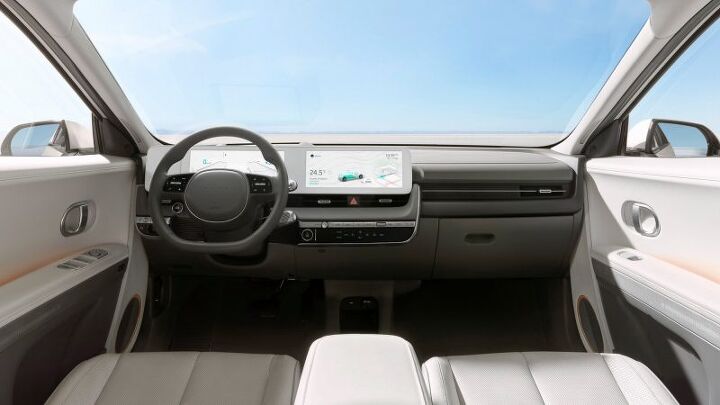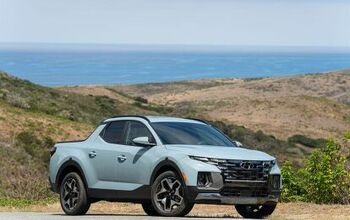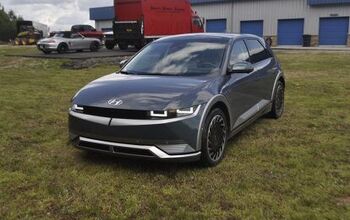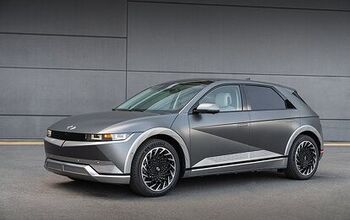The Right Spec: 2022 Hyundai IONIQ 5

Viewed in a vacuum, especially through the filtered lens of an online picture, the Hyundai IONIQ 5 might appear to be a hatchback roughly the size of a VW Golf. In reality, it’s a lot more crossover-like inside and out, with the added bonus of seating flexibility that eliminates a space-hogging center console which creates a spiritual successor to the old-school bench seat.
There is a quartet of trims offered in our market, starting with the $39,700 SE Standard Range with its single motor and rear-wheel drive.
That’s good for 168 horsepower and an estimated 220 miles from its 58.0-kWh battery pack. If those numbers aren’t appealing, an extra $3,950 will net the SE trim (sans the ‘Standard Range’ moniker) which has a 77.4-kWh battery and approximately 300 miles of range. Interestingly, a rear-drive IONIQ 5 with the larger battery makes 225 horses, pushing the all-electric car to 60 mph from rest in about 7.4 seconds according to Hyundai.
Looking for dual motors and 320 horsepower? You’ll need to upgrade to an all-wheel-drive model, a configuration offered on all trims save for the entry-level SE Standard Range. This is a wise decision by Hyundai since it means customers can get the most powerful options without having to pop for a bucks-deluxe trim level. Note that, thanks to extra weight and other gubbins, the estimated range drops to an indicated 256 miles in the all-wheel-drive model. The least expensive AWD wears a sticker price of $47,550.
Externally, there’s not a ton of difference between the four trims, meaning your snooty neighbors won’t know the difference if you bought the least- or most-expensive IONIQ 5. There’s something to be said for creative design, a signature characteristic of this car with its dot-matrix fore and aft lighting which somehow manages to recall sealed beam headlamps but in a way that’s thoroughly modern. The top two trims do feature a unique-to-them front ‘v’ light bar and some extra silver-look garnish.
Inside, the SE is this car’s only trim with cloth seats; if it’s that upholstery you’re after, go ahead and end your search right there. All trims get heated seats, a large 12.3-inch infotainment touchscreen paired with an equal-size digital gauge cluster, dual-zone climate, and safety nannies like smart cruise control. The SEL sets itself apart by including comforts like wireless device charging and a heated steering wheel plus 2nd-row ventilation and a power liftgate.
Limited trim ($50,600 or $54,500 with all-wheel drive) adds vehicle-to-load technology via a two-way onboard charger in the second row. This permits owners to use their car as an enormous battery pack, allowing the electric car to power everyday items when it would otherwise be sitting idle. Whether this is a selling point is up to individual preferences, but we can think of ample opportunities to press this into service both on the road and at home. Typical comfort stuff like a heads-up display and Bose audio also pop up on the Limited.
An all-wheel-drive SEL and rear-wheel drive Limited both come in right around 50 grand, making for an interesting choice of vehicles. The former has a lot more power and can whip to 60 mph in about five seconds, while the latter has braggable-to-EV-friends features like being able to power items in your home. We’d choose the extra power and AWD grip, naturally.
Please note the prices listed here are in Yankee bucks and are currently accurate for base prices exclusive of any fees, taxes, or rebates. Your dealer may (and should) sell for less (obscene market conditions notwithstanding). Keep your foot down, bone up on available rebates, and bargain hard.
[Images: Hyundai]

Matthew buys, sells, fixes, & races cars. As a human index of auto & auction knowledge, he is fond of making money and offering loud opinions.
More by Matthew Guy
Latest Car Reviews
Read moreLatest Product Reviews
Read moreRecent Comments
- Teddyc73 Oh good lord here we go again criticizing Cadillac for alphanumeric names. It's the same old tired ridiculous argument, and it makes absolutely no sense. Explain to me why alphanumeric names are fine for every other luxury brand....except Cadillac. What young well-off buyer is walking around thinking "Wow, Cadillac is a luxury brand but I thought they had interesting names?" No one. Cadillac's designations don't make sense? And other brands do? Come on.
- Flashindapan Emergency mid year refresh of all Cadillac models by graphing on plastic fenders and making them larger than anything from Stellantis or Ford.
- Bd2 Eh, the Dollar has held up well against most other currencies and the IRA is actually investing in critical industries, unlike the $6 Trillion in pandemic relief/stimulus which was just a cash giveaway (also rife with fraud).What Matt doesn't mention is that the price of fuel (particularly diesel) is higher relative to the price of oil due to US oil producers exporting records amount of oil and refiners exporting records amount of fuel. US refiners switched more and more production to diesel fuel, which lowers the supply of gas here (inflating prices). But shouldn't that mean low prices for diesel?Nope, as refiners are just exporting the diesel overseas, including to Mexico.
- Jor65756038 As owner of an Opel Ampera/Chevrolet Volt and a 1979 Chevy Malibu, I will certainly not buy trash like the Bolt or any SUV or crossover. If GM doesn´t offer a sedan, then I will buy german, sweedish, italian, asian, Tesla or whoever offers me a sedan. Not everybody like SUV´s or crossovers or is willing to buy one no matter what.
- Bd2 While Hyundai has enough models that offer a hybrid variant, problem has been inadequate supply, so this should help address that.In particular, US production of PHEVs will make them eligible for the tax credit.



































Comments
Join the conversation
Saw my first one just yesterday, a very handsome car, looks far more expensive than it is. Nice size and packaging and much more like a wagon than an SUV.
I like the interior. But I don't see the value over let's say a Mach-E or even a Bolt EUV